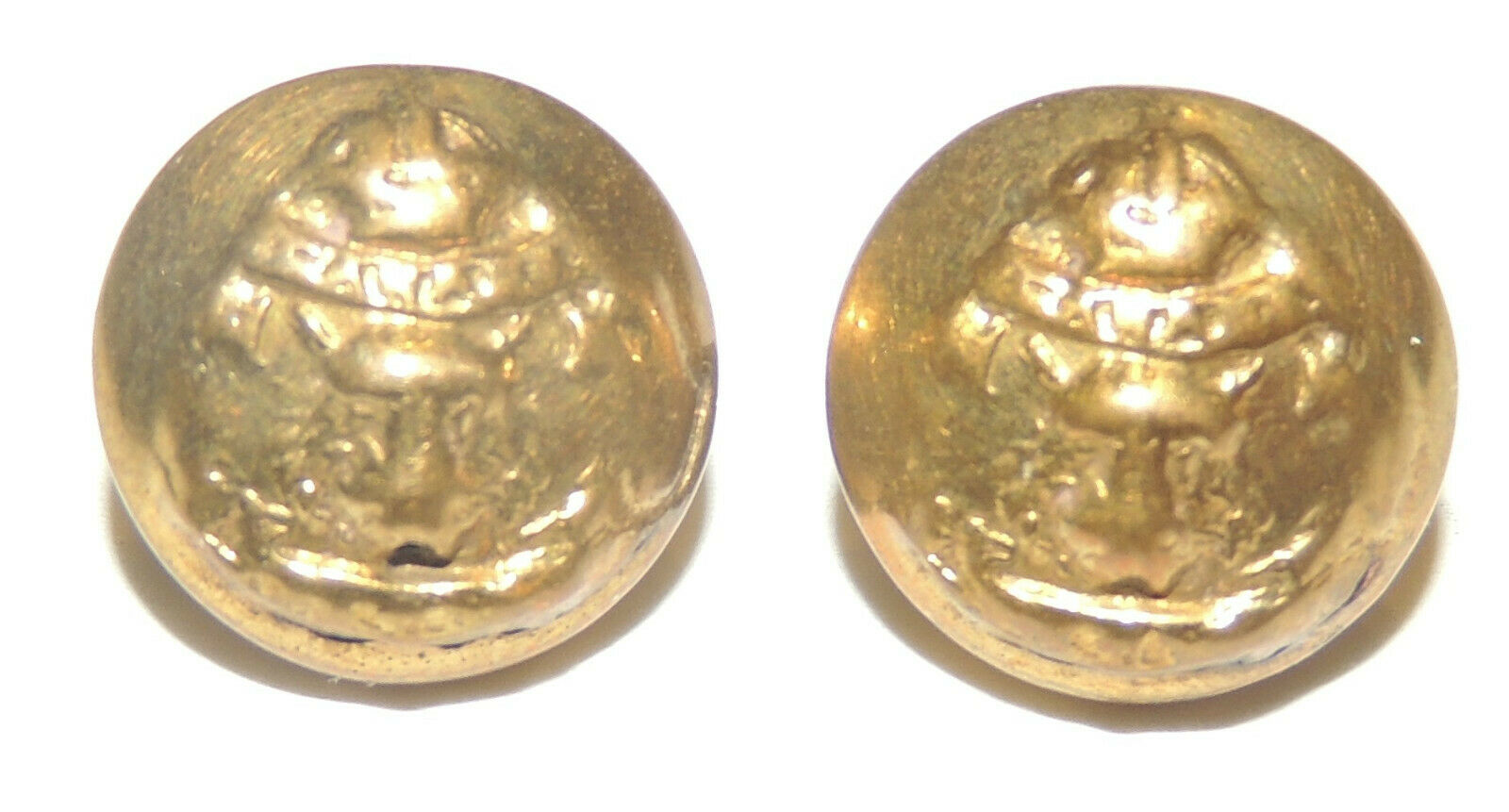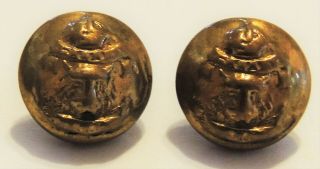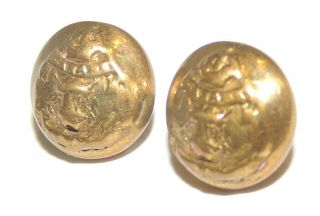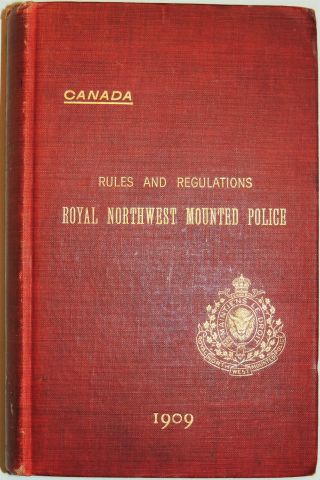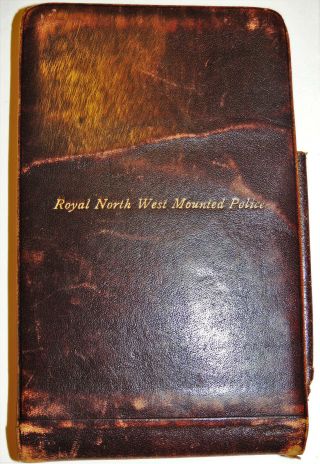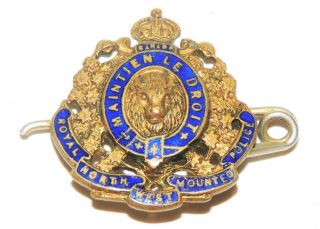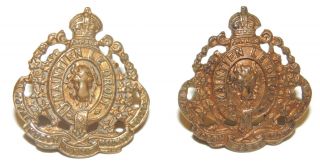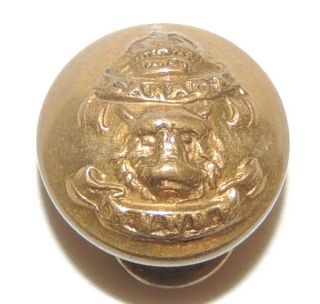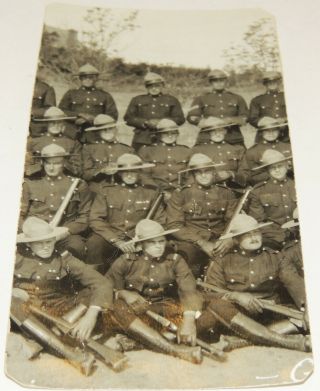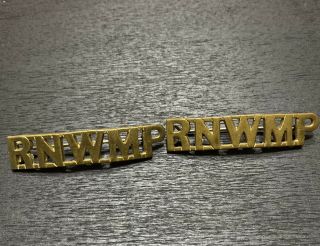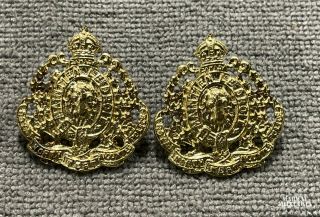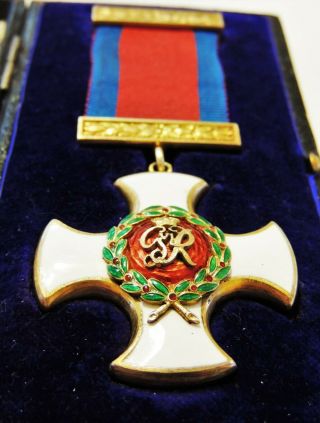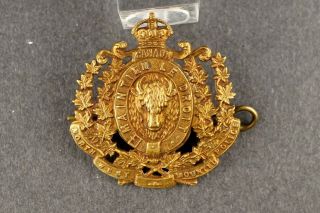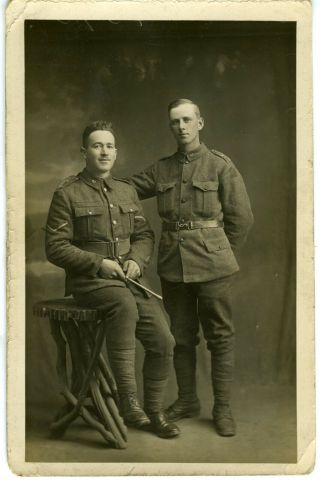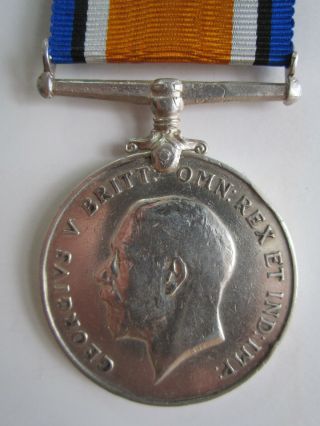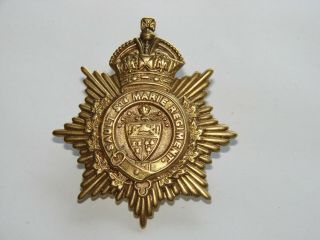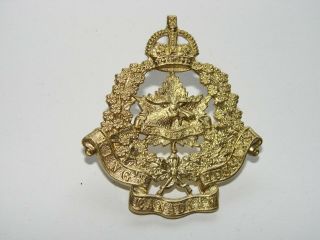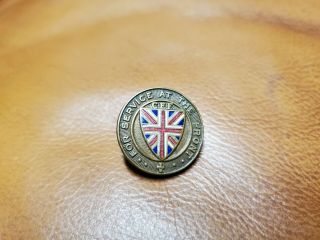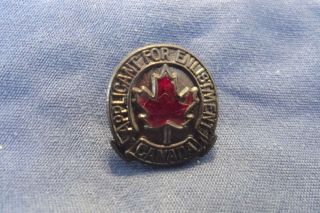OBSOLETE NWMP RNWMP Royal North West Mounted Police WW1 Small Cap Button Pair
Item History & Price
| Reference Number: Avaluer:14252952 |
------NOTE: ALL POLICE BADGES ARE OBSOLETE and over 70+ years old!!!!! ------
Russell Militaria is proud to present a selection of NWMP/RNWMP and Early Mounted Police items from my personal collection. These items were taken care and enjoyed on display; and it is time to pass them on to museums and private collections where they can be seen. Many of the North West Mounted Police/ Royal North West Mounted Police items are incredibly hard to find and sought after- these would look w...onderful in your collection!
Up for auction is an original pair of NWMP or RNWMP ( Royal North West Mounted Police) wedge cap or peaked cap side buttons in worn condition. The buttons have the Kings Crown on top, a well rubbed off scroll below the center bison and a "Canada" scroll above. I beleive these are likely R.N.W.M.P. buttons with a slight chance of being the Kings Crown N.W.M.P. buttons, however the lower scrolls have been rubbed off due to excessive wear. The buttons shows signs of wear from use on the face, yet retain a good amount of detail. The reverse of both buttons are unmarked, and both have their original fastener.
These buttons are notoriously easy to lose due to their small size, and this would be an excellent original replacement pair for a wedgecap/peaked officers cap that has lost its original buttons! Please see my other auctions for a RNWMP button!
This was purchased from the extensive collection of RNWMP/Mounted Police veteran A.E. Smith- please see my other auctions for other items from the collection!
Good luck and happy bidding!
History on the North West Mounted Police, Royal North West Mounted Police & R.C.M.P:
North West Mounted Police and Royal North West Mounted Police (N.W.M.P. + R.N.W.M.P.):
The North-West Mounted Police (NWMP) was a Canadian police force, established in 1873 by the Prime Minister, Sir John Macdonald, to maintain order in the North-West Territories. The mounted police combined military, police and judicial functions along similar lines to the Royal Irish Constabulary, and deployed the following year to the Alberta border in response to the Cypress Hills Massacre and subsequent fears of a United States military intervention. Their ill-planned and arduous journey of nearly 900 miles (1, 400 km) became known as the March West and was portrayed by the force as an epic journey of endurance. Over the next few years, the police extended Canadian law across the region, establishing good working relationships with the First Nations. The force formed part of the military response to the North-West Rebellion in 1885, but faced criticism for their performance during the conflict.
The mounted police assisted in the construction of the Canadian Pacific Railway, including relocating indigenous communities living along the route. The force established a wide network of posts and patrols, enabling them to protect and assist the ranchers who created huge cattle businesses across the prairies. The living conditions of the police on the prairies were spartan and often uncomfortable, and only slowly improved over the course of the century. Meanwhile, the railway enabled more settlers to migrate west, creating new towns and industries, while the force restricted the First Nations to the reserves. The mounted police faced challenges in adapting to the changing situation, especially when applying the unpopular prohibition laws to the white community. The force also became drawn into the growing number of industrial disputes between organised labour and company owners.
By 1896, the government planned to pass policing responsibilities to the provincial authorities and ultimately close the force. With the discovery of gold in the Klondike, however, the force was redeployed to protect Canada's sovereignty over the region and to manage the influx of prospectors. The mounted police sent volunteers to fight in the Second Boer War, and in recognition were retitled the Royal North-West Mounted Police in 1904. The plans for closure were abandoned in the face of opposition from regional politicians. Large numbers of the police volunteered for military service during the First World War, and the future of the badly depleted force was once again in doubt. Towards the end of the war, however, fears grew about a potential Bolshevik conspiracy and the authorities tasked the mounted police to investigate the threat. In the aftermath of the violence of the Winnipeg General Strike, the government decided to amalgamate the force with the Dominion Police, to form the Royal Canadian Mounted Police in 1920.
Many popular novels were published about the mounted police from 1885 onwards, and in the 20th century over 250 films were made, along with radio and television portrayals. The police were depicted as courageous, disciplined and chivalrous, displaying a sense of fair-play as they brought their suspects to justice. Historians, working from initially limited public records and chronicles, wrote similarly eulogistic accounts of the mounted police, but as new archives became available in the 1970s, more critical and analytic accounts of the force were produced. The force heavily influenced public perceptions of the Royal Canadian Mounted Police, which used the North-West Mounted Police's image and history to help make the modern police a popular Canadian national symbol.
Royal Canadian Mounted Police (R.C.M.P):
The force added "royal" to its name in 1904. It merged with the Dominion Police, the main police force for all points east of Manitoba, in 1920 and was renamed the "Royal Canadian Mounted Police". The new organization was charged with federal law enforcement in all the provinces and territories, and immediately established its modern role as protector of Canadian national security, as well as assuming responsibility for national counterintelligence.
In 1935, the RCMP, collaborating with the Regina Police Service, crushed the On-to-Ottawa Trek by sparking the Regina Riot, in which one city police officer and one protester were killed. The Trek, which had been organized to call attention to the abysmal conditions in relief camps, therefore failed to reach Ottawa, but nevertheless had profound political reverberations. The RCMP also lost four officers in Saskatchewan and Alberta that year in what became the 1935 Royal Canadian Mounted Police Killings.
The RCMP employed special constables to assist with strikebreaking in the interwar period. For a brief period in the late 1930s, a volunteer militia group, the Legion of Frontiersmen, were affiliated with the RCMP. Many members of the RCMP belonged to this organization, which was prepared to serve as an auxiliary force. In later years, special constables performed duties such as policing airports and, in some Canadian provinces, the courthouses.
In 1932 saw the men, vehicles and vessels of the Customs Preventive Service, National Revenue, absorbed by the RCMP. This created the Marine Section and the Excise Section. The acquisition of the RCMP schooner St. Roch facilitated the first effective patrol of Canada's Arctic territory. It was the first vessel to navigate the Northwest Passage from west to east (1940–42), the first to navigate the passage in one season (from Halifax to Vancouver in 1944), the first to sail either way through the passage in one season, and the first to circumnavigate North America (1950).
Counterintelligence work was moved from the RCMP's Criminal Investigation Department to a specialized intelligence branch, the RCMP Security Service, in 1939.
At the outbreak of World War II, the Canadian Army was without any form of military police. On September 13, 1939, the Royal Canadian Mounted Police (RCMP) requested and received permission to form a Provost Company using volunteers from its ranks. This was designated 1 Provost Company (RCMP), of the 1st Canadian Infantry Division, Canadian Active Service Force. Initially, it was 120 men; many of them were in the UK by the end of 1939.
On April 1, 1949, Newfoundland joined in full confederation with Canada and the Newfoundland Ranger Force amalgamated with the RCMP.
Following the 1945 defection of Soviet cipher clerk, Igor Gouzenko, and his revelations of espionage, the RCMP Security Service implemented measures to screen out "subversive" elements from the public sector.
In June 1953, the RCMP became a full member of the International Criminal Police Organisation (Interpol).
Queen Elizabeth II approved in Regina, Saskatchewan, on July 4, 1973, a new badge for the RCMP, in recognition of which the force presented the sovereign with a tapestry rendering of the new design.
In the late 1970s, revelations surfaced that the RCMP Security Service force had in the course of their intelligence duties engaged in crimes such as burning a barn and stealing documents from the separatist Parti Québécois, and other abuses. This led to the Royal Commission of Inquiry into Certain Activities of the RCMP, better known as the "McDonald Commission", named for the presiding judge, Justice David Cargill McDonald. The commission recommended that the force's intelligences duties be removed in favour of the creation of a separate intelligence agency, the Canadian Security Intelligence Service (CSIS).
I combine shipping! Foreign buyers please wait until after I have sent you an invoice, as all packages must be shipped tracked!Good luck and Happy bidding! I combine shipping on ALL purchases!!!
Please see my other auctions for great militaria!
If you have any questions, additional photo requests comments or further information on this item, please contact me and I will get back to you asap!
------------------------------------------------------------------------------
R U S S E L L M I L I T A R I A is proud to bring you new militaria every month!
Information:
-Customer satisfaction is very important to us- if you have any questions, comments or information please let me know before leaving feedback and I will work hard to make sure you are satisfied!
-We reserve the right to end all auctions at any time!
-All items shipped outside of Canada and U.S. (with some minor exceptions) MUST be insured and tracked to avoid theft and loss! This protects both the buyer and seller and ensures the safety of the item.
------------------
Shipping
------------------
-We work hard to find the most affordable and safe rate for you! Please wait until AFTER I have sent you an invoice before paying for your item, especially for bidders outside of Canada and U.S. as shipping rates vary widely.
Thank you and happy bidding!! :)



